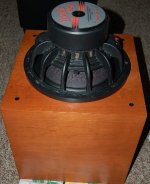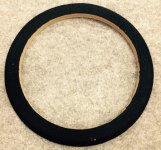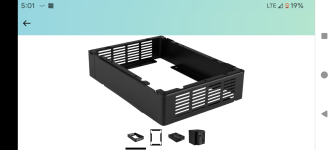No, thanks.
Looks like I'll stick with (2 total) one 12" in 1.4ft3 + stuffing per stereo channel, with 250W/4ohms on tap (classD). I'm certain this will extend my main speakers (8"woofer QTC 0.85 @ 80hz). Again, this is for music, not LFE. I hope the damping will be tight enough for good res.
Thanks again.
-C
Looks like I'll stick with (2 total) one 12" in 1.4ft3 + stuffing per stereo channel, with 250W/4ohms on tap (classD). I'm certain this will extend my main speakers (8"woofer QTC 0.85 @ 80hz). Again, this is for music, not LFE. I hope the damping will be tight enough for good res.
Thanks again.

-C
Well, I tried out the 1259 in the small box, and it's not a good "fit", acoustically (you were right) 👎
Humbly, I have learned the difference between tenacity and stubbornness.Open:mind
I have another driver on-hand (Dayton) that appears to be more compatible with smaller boxes. Hopefully, I can still get your input 🙏
I will post info once I locate it.
-C
Humbly, I have learned the difference between tenacity and stubbornness.Open:mind
I have another driver on-hand (Dayton) that appears to be more compatible with smaller boxes. Hopefully, I can still get your input 🙏
I will post info once I locate it.
-C
Last edited:
What EQ and HP LP settings did you use to determine the 1259 in the small box was not a good "fit", acoustically?
Did you do any measurements of the response with and without processing?
Did you do any measurements of the response with and without processing?
I tried it without EQ, with a 25 Hz HP infrasonic."rumble" filter, and a 100hz lowpass, crossing over to my Dynaudio towers at 100hz 12db/octave. No test gear, other than playing recodings of solo drum kit, bass guitar, and also some bass test tracks.
My friend and I listened with sub and with main speakers full range(sealed 20w75 with Qtc=~0.8). The 1259 in 1.4ft3 box was quite boomy with quite noticeable "hangover" compared to the 8" Dynaudio. Also it didn't go as low as a sub(not that much lower than the 8").
Also, we calculated that with any EQ and bass boost, the 6ohm NHT woofer would need more power than the SP250 could provide on peaks and was limited to <97db @ 30hz.
My buddy suggested that I use another woofer I had on my shelf, the 12" Titanic mk2(which has a Vas half as big, 50% more Xmax, is almost twice as sensitive and has greater power handling. I previously dismissed the Titanic, as I only had a single unit (but just located a second locally for a good price). I was trying to justify using the 1259's I had, much like trying to force a square peg into a round hole. I will probably sell the NHT's to help pay for the amps.
Now to re-run the numbers...🤔
-C
My friend and I listened with sub and with main speakers full range(sealed 20w75 with Qtc=~0.8). The 1259 in 1.4ft3 box was quite boomy with quite noticeable "hangover" compared to the 8" Dynaudio. Also it didn't go as low as a sub(not that much lower than the 8").
Also, we calculated that with any EQ and bass boost, the 6ohm NHT woofer would need more power than the SP250 could provide on peaks and was limited to <97db @ 30hz.
My buddy suggested that I use another woofer I had on my shelf, the 12" Titanic mk2(which has a Vas half as big, 50% more Xmax, is almost twice as sensitive and has greater power handling. I previously dismissed the Titanic, as I only had a single unit (but just located a second locally for a good price). I was trying to justify using the 1259's I had, much like trying to force a square peg into a round hole. I will probably sell the NHT's to help pay for the amps.
Now to re-run the numbers...🤔
-C
Attachments
So you didn't try the linkwitz transform.
It's not a surprise you found it boomy and lacking extension. And too bad you did not get past this try as you did not experienced what linearisation brings. And with the highpass filter engaged as suggested by Art, you would have gained in overall output.
If you can just push the try to the max: setup your measurement mic and an rta ( Rew is free and already been mentioned) and try to program the dsp amp to reach the target given previously: this step is important for the overall results...
And as you have a Titanic availlable too compare them in the same box with same target and see by yourself if one is better than the other for your own preference.
It's not a surprise you found it boomy and lacking extension. And too bad you did not get past this try as you did not experienced what linearisation brings. And with the highpass filter engaged as suggested by Art, you would have gained in overall output.
If you can just push the try to the max: setup your measurement mic and an rta ( Rew is free and already been mentioned) and try to program the dsp amp to reach the target given previously: this step is important for the overall results...
And as you have a Titanic availlable too compare them in the same box with same target and see by yourself if one is better than the other for your own preference.
Will try comparing both sides by side.
Unfortunately, the only measurement mic I have on hand is the little Dayton iMM6 mounted on an old iPhone 5s (my good cal. mic was borrowed & never got returned 😠).
Because the big woofers displace a even more box volume I'll use some 1" thick spacer rings and will be mounting the amps externally, closing the 9" square hole in each box with a thick aluminium plate.
I will try to locate REW- is it available as an app for iOS?
-C
Unfortunately, the only measurement mic I have on hand is the little Dayton iMM6 mounted on an old iPhone 5s (my good cal. mic was borrowed & never got returned 😠).
Because the big woofers displace a even more box volume I'll use some 1" thick spacer rings and will be mounting the amps externally, closing the 9" square hole in each box with a thick aluminium plate.
I will try to locate REW- is it available as an app for iOS?
-C
Attachments
Sadly people tends to keep the borrowed things, i know the issue too.
But you don't need ultimate accuracy for this ( at least at first), just a way to get closer to the 0,707 curve you target.
Rew is computer software so no chance it run on a smartphone but there is free RTA application on IOS for sure.
I don't use apple thingy so can't tell which one but i think it shouldn't be difficult to find one.
When i talked about comparison it is for corrected system ( Linkwitz Transform applied) with both loudspeakers.
'Au naturel' there will be too much difference between both units.
Don't be frightned to try it even with an not this much accurate mic, it's just for you to make your mind about the need to spend money on another driver or not.
Do you listen this loud that you need more than 100db peak spl?
But you don't need ultimate accuracy for this ( at least at first), just a way to get closer to the 0,707 curve you target.
Rew is computer software so no chance it run on a smartphone but there is free RTA application on IOS for sure.
I don't use apple thingy so can't tell which one but i think it shouldn't be difficult to find one.
When i talked about comparison it is for corrected system ( Linkwitz Transform applied) with both loudspeakers.
'Au naturel' there will be too much difference between both units.
Don't be frightned to try it even with an not this much accurate mic, it's just for you to make your mind about the need to spend money on another driver or not.
Do you listen this loud that you need more than 100db peak spl?
From what I've read, a power limitation of 97dB before EQ would seem to limit the SOA, where another 3db sensitivity and ~20% more power handling of the Dayton driver may give the extra margin I need for both music & home theater use.
BTW, I saw a YouTube video on using the iMM6 WITH an Acer Win10 laptop; unfortunately, my Acer Win10 doesn't seem to recognize the mic(it has aTRRS input), and just shows the built-in mic array as the only available selection.
I'm loathe to buy yet a 3rd microphone(probably a calibrated USB model) for a one-time use, so I'll try one of the iOS apps with my iMM6 to see if they calculate the necessary PEQ filters or not.
Any tips to resolve the above issue would be greatly appreciated. 🙏
-C
BTW, I saw a YouTube video on using the iMM6 WITH an Acer Win10 laptop; unfortunately, my Acer Win10 doesn't seem to recognize the mic(it has aTRRS input), and just shows the built-in mic array as the only available selection.
I'm loathe to buy yet a 3rd microphone(probably a calibrated USB model) for a one-time use, so I'll try one of the iOS apps with my iMM6 to see if they calculate the necessary PEQ filters or not.
Any tips to resolve the above issue would be greatly appreciated. 🙏
-C
I don't do Apple (other than for eating) so this is very 2nd hand info but Studio Six's AudioTools suite is quite well regarded in pro circles - if they have something suitable it'll probably work well.
Using two drivers increases sensitivity by 3dB.From what I've read, a power limitation of 97dB before EQ would seem to limit the SOA, where another 3db sensitivity and ~20% more power handling of the Dayton driver may give the extra margin I need for both music & home theater use.
Any tips to resolve the above issue would be greatly appreciated. 🙏
The power handling is not an issue, the amount of power available from your amp is.
Whether you use the Titanic or a pair of 1259, you will need to engage the EQ to get rid of "boom" and "hangover", you don't need any test equipment for that 😉
Well yeah.
If a sub wants 3 cubic feet and you put it in 1.4
I would expect it to be " boomy " and " slow" sounding
and many other descriptions people use
to describe a woofer not in a ideal enclosure.
EQ doesn't change the box size or mechanical properties.
Sometimes it is part of the learning process.
Staring at a sim and making up stuff in your head
saying it will work. And in real life after building the box it doesn't.
I have been there, and small boxes are needed in some applications.
Just a learning process with real world listening tests.
And being aware of what you thought in sim was ok.
How it plays out in the real world.
You understand what it looks like and does, not assume
After friends tossing endless sheets of wood and chuffy slow boomy bass.
I just leaned towards lower Qts 12" speakers.
Hit BB4 or QB3 alignment whatever it says the volume is
that is what it is. Use flared round ports
for 18 to 22ms velocity at LINEAR power not thermal.
And those alignment thingy's start to make sense.
And why " Flat" high tuned nonsense dont work.
After getting it right, depending on source material.
The basic bass boost/cut shelf filter built into the amp
was all that was needed. Depending on the music.
To get rid of the flapping or weird cone roll
from songs that really knock. The common 4th
order excursion filter about 7 to 12 Hz below Fb
flared ports, no slot ports.
Transfer function rolls off, not "flat"
BB4 or QB3 that is what it wants.
that is what it gets.
Cut or boost with shelf filter depending on
song / source material.
If high Qts the box is gonna be BIG
no way around it.
Ohms law is ohms law.
You dont " get" more power from
low impedance. You " Use" more power.
Current levels double, the transformer dont
get bigger. It has to be bigger.
If a sub wants 3 cubic feet and you put it in 1.4
I would expect it to be " boomy " and " slow" sounding
and many other descriptions people use
to describe a woofer not in a ideal enclosure.
EQ doesn't change the box size or mechanical properties.
Sometimes it is part of the learning process.
Staring at a sim and making up stuff in your head
saying it will work. And in real life after building the box it doesn't.
I have been there, and small boxes are needed in some applications.
Just a learning process with real world listening tests.
And being aware of what you thought in sim was ok.
How it plays out in the real world.
You understand what it looks like and does, not assume
After friends tossing endless sheets of wood and chuffy slow boomy bass.
I just leaned towards lower Qts 12" speakers.
Hit BB4 or QB3 alignment whatever it says the volume is
that is what it is. Use flared round ports
for 18 to 22ms velocity at LINEAR power not thermal.
And those alignment thingy's start to make sense.
And why " Flat" high tuned nonsense dont work.
After getting it right, depending on source material.
The basic bass boost/cut shelf filter built into the amp
was all that was needed. Depending on the music.
To get rid of the flapping or weird cone roll
from songs that really knock. The common 4th
order excursion filter about 7 to 12 Hz below Fb
flared ports, no slot ports.
Transfer function rolls off, not "flat"
BB4 or QB3 that is what it wants.
that is what it gets.
Cut or boost with shelf filter depending on
song / source material.
If high Qts the box is gonna be BIG
no way around it.
Ohms law is ohms law.
You dont " get" more power from
low impedance. You " Use" more power.
Current levels double, the transformer dont
get bigger. It has to be bigger.
Last edited:
Thanks all.
You're right- this is been a good learning experience for me.
Rather than griping anymore,
I GAVE iN 😮💨 and ordered a USB calibrated microphone from Parts Express. Plus I downloaded a copy of REW to my laptop. Hopefully now I will be able to accomplish my goals of optimizing bass response in my room- I certainly have the gear.
It turns out that by cramming the box full of > Lb of AcoustaStuff, the Titanic2 is sounding better on plucked bass and kick drum; in fact, on Pink Floyd DSOM last night I could feel the heartbeat shake my floor!
Can't wait to join the cognoscenti!
-C
You're right- this is been a good learning experience for me.
Rather than griping anymore,
I GAVE iN 😮💨 and ordered a USB calibrated microphone from Parts Express. Plus I downloaded a copy of REW to my laptop. Hopefully now I will be able to accomplish my goals of optimizing bass response in my room- I certainly have the gear.
It turns out that by cramming the box full of > Lb of AcoustaStuff, the Titanic2 is sounding better on plucked bass and kick drum; in fact, on Pink Floyd DSOM last night I could feel the heartbeat shake my floor!
Can't wait to join the cognoscenti!
-C
Attachments
- Home
- Loudspeakers
- Subwoofers
- How do we use DSP to compensate for higher than optimum Qtc in subwoofers?




